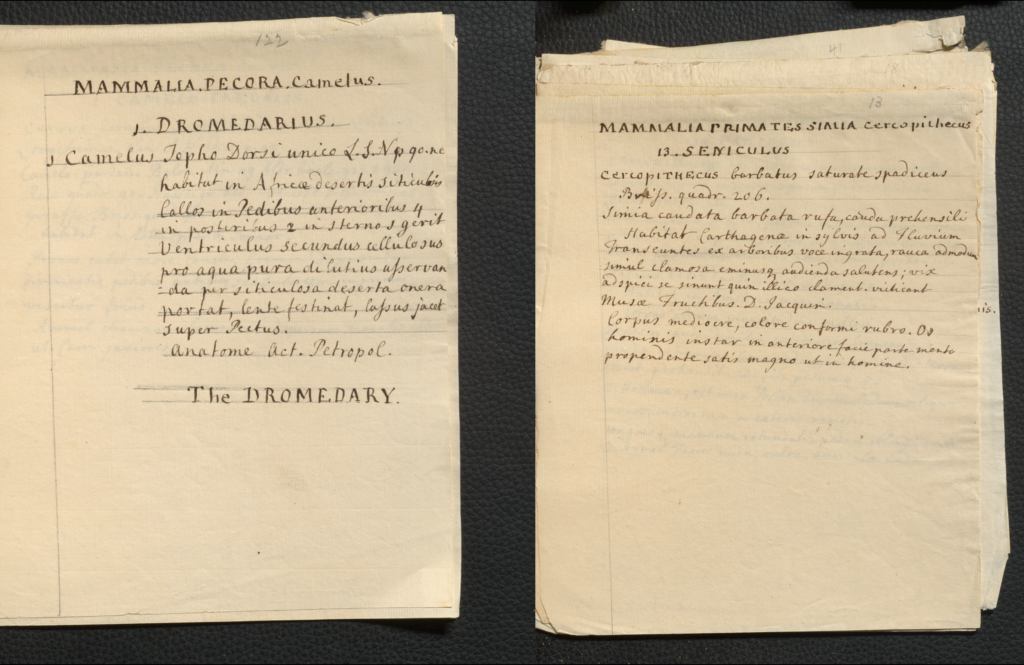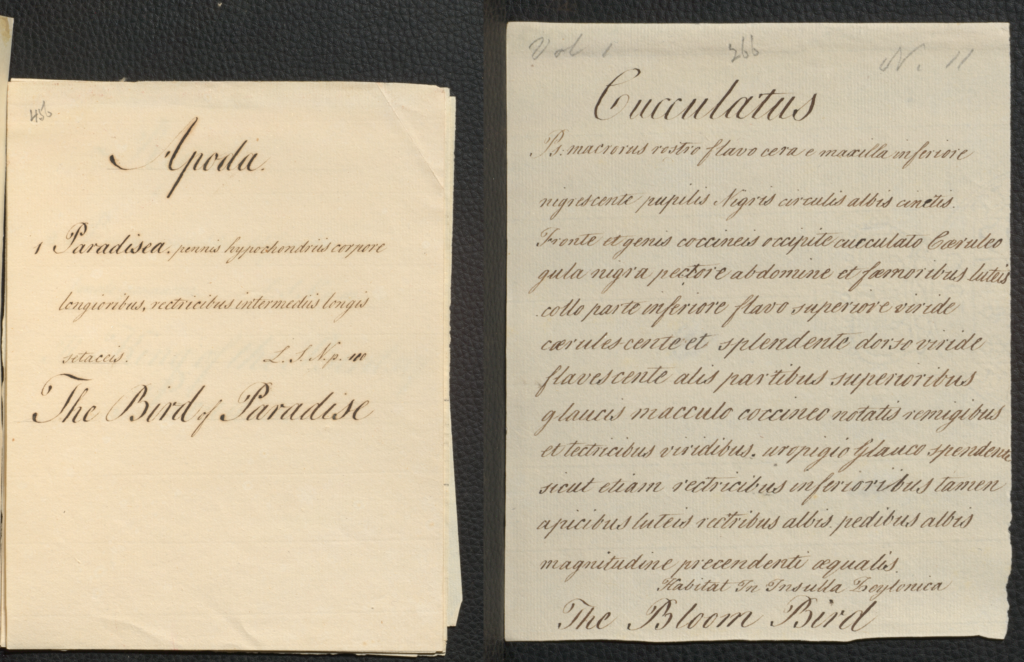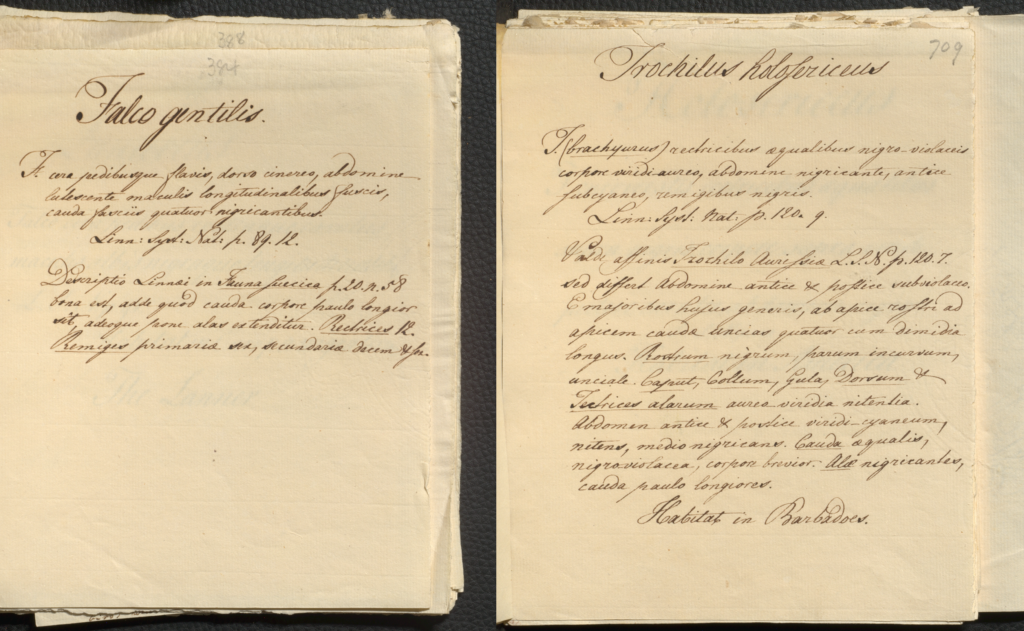The Manuscript Notes
Taylor White’s collection of images is accompanied by over 700 manuscript notes, likely compiled subsequently to the images, beginning in the 1750s. These notes offer short descriptions of the painted animals (ranging in length from a few words to several paragraphs), along with their Latin and common English names, and their country of origin. Links to high resolution images of White’s notes can be found at the bottom of this page. One particular feature of Taylor White’s notes is the fact that they are written sometimes entirely in Latin, sometimes entirely in English, and sometimes in a combination of the two languages. This is representative of the shift in language used for scientific purposes that was becoming more prominent during the eighteenth century in several areas of Europe: Latin, which had previously been the dominant language, was gradually being replaced by vernaculars.
In many of his notes, White copied Latin descriptions published in Carl Linnaeus’ Systema Naturae. He also frequently made reference to other authors such as Mathurin Jacques Brisson, and Francis Willughby, who published in French and English respectively. At the same time, however, White was also adding his own comments and observations about the animals he was having painted; these he would also write sometimes in Latin and sometimes in English. It would seem, then, that his notes served as more than simply a second form of description (i.e. verbal rather than visual), but offered a space where White could question, and contribute to, pre-existing knowledge of the animals he was describing.
When looking at the physical notes in and of themselves, the vast majority would appear to be fairly rough drafts, written in Taylor White’s own hand. These often include words crossed out and added in, or notes hastily added at a later time. It would also seem that both his handwriting and the format of his notes changed over the years as he added to his collection. In certain places, he also seems to have left extra space with the intention of coming back to some notes at a later date.

At the same time, however, Taylor White also appears to have been compiling these notes with the goal of displaying them alongside his collection of paintings in a potential exhibition, or else including them as part of a publication which he hoped to complete, but never realized. In a letter to John Ellis (1710-76) Daniel Solander reveals that Mr White “intends to publish his figures in a large work, of which he hopes that the King will be at the expence” (see this reference to White’s planned publication here). This would in fact seem to be the case, given that several of his notes (primarily from his earlier volumes on birds) were copied out in quite a refined hand as seen in the examples below. Unfortunately, for the majority of the ‘clean’ notes that were made, their original draft counterparts no longer seem to exist.

We believe that this particular hand possibly belonged to White’s wife Fanny or one of his daughters, Anne or Frances, and could thus demonstrate the role of women in scientific activity during this period. The pursuit of scientific knowledge during the early modern period was a collective process that often took place in the home and involved all family members. Women would not only have assisted their husbands in their particular endeavours but could quite acceptably practice midwifery, study astronomy, and take part in botanical illustration, among other pursuits. Carl Linnaeus’ daughter, Elisabeth Christina (Lisa Stina), for example, even published a paper on her observations of the luminescence of nasturtiums with the Royal Swedish Academy of Sciences in 1762 (see Alix Cooper, Homes and Households and Lisa Vargues, Flashes in the Twilight). Women also often worked as artists and colourists during this period, and elite women especially were expected to be able to write. Fair copies that were made of Joseph Banks’ journal from his voyage aboard the H.M.S. Endeavour, as well as of the journal he kept on a later expedition to Iceland can serve as a further example of women’s roles in scientific writing during this period. It is believed that the fair copy of Banks’ Endeavour journal was made either by George III’s daughter Princess Elizabeth and corrected by Banks’ sister Sarah Sophia, or perhaps by Maria Dawson Turner, daughter of the botanist Dawson Turner, and wife of another botanist, William Jackson Hooker. The fair copy of his journal from his voyage to Iceland, in turn, has been attributed to his sister Sarah Sophia Banks (see Anna Agnarsdóttir, Sir Joseph Banks, Iceland and the North Atlantic – “Introduction to the Journals”). It is very possible then, that Taylor White perhaps requested the assistance from one of the women in his family to make clean versions of his notes.
What is curious, however, is that in addition to the hand shown above, another different refined hand also appears throughout the notes.

Could this be the hand of another one of the women in Taylor White’s family? Or did this hand perhaps belong to a clerk or assistant hired by White? These changes in handwriting can also lead to further questions about Taylor White’s note-taking process. For example, why are only some notes written in a refined hand? Why is the refined hand not always the same? What happened to Taylor White’s original drafts of those notes? Did he destroy them once the clean versions had been made? Why do the notes on mammals seemingly only exist in a draft form? Did Taylor White abandon the idea of publication part way through his collection process? Or did something else prevent his copyist from finishing the project? As these questions demonstrate, it is not only the contents of the notes that are worth examining, but also their physical aspect, as this can reveal different kinds of information on the process of collecting, note-taking, and everyday life in the eighteenth century.

Click here to browse high-resolution digital reproductions of the notes mentioned here, as well as others in the Taylor White Collection.
For the specific volumes which include the above notes, see:
Birds Volume 1, Note 266
Birds Volume 3, Note 373
Birds Volume 4, Note 384
Birds Volume 5, Note 437
Birds Volume 12, Note 709
Mammals Volume 1, Notes 13 and 30
Mammals Volume 2, Note 44
Mammals Volume 3, Note 122
–Emilienne Greenfield
